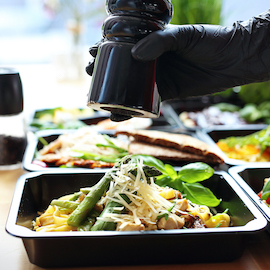 Weight loss is incredibly difficult because so much of the process is psychological. When you have an impulse or craving, you’re experiencing a powerful decision-making influencer. Takeout food, for instance, is easy, comforting and saves time. It’s an instant gratification that manipulates your would-be logical thinking with emotional triggers. But if you limit these day-to-day meal decisions, when you’re most vulnerable to slip up, you can remove impulse from the equation and replace it with good habits.
Weight loss is incredibly difficult because so much of the process is psychological. When you have an impulse or craving, you’re experiencing a powerful decision-making influencer. Takeout food, for instance, is easy, comforting and saves time. It’s an instant gratification that manipulates your would-be logical thinking with emotional triggers. But if you limit these day-to-day meal decisions, when you’re most vulnerable to slip up, you can remove impulse from the equation and replace it with good habits.
Enter meal preparation, the practice of planning and making your meals ahead of time. With dinner in the fridge and ready to go, you cancel unplanned episodes of “takeout jeopardy,” which so often end with you at the fast-food window. And because you’re the one preparing your food, you can tailor recipes to meet your caloric needs, cutting the fattening, simple carbohydrates found in processed meals. But truth be told, we often overemphasize the cooking element of dieting, because it’s not always what you eat, but how much.
When you’re trying to lose weight, overeating can be a common problem. Research shows people naturally eat more food when larger portions are provided. Fortunately, portion control is one of meal preparation’s strongest suits. Using food containers, you can divvy up smaller portions of a larger meal, creating lunches and dinners throughout the week. But you’ll need to commit to a little planning, shopping and cooking.
Pick a cooking day, and before you hit up the grocery store, decide what your meals will be and what ingredients you’ll need. Recipes are easy to find online and shockingly simple. An investment, for instance, in an affordable crock pot, often requires that you only add ingredients and set the slow cooker for a designated amount of time.
Meal preparation strategies can make cooking and preparing food easy, but the benefits extend beyond weight loss. Prepping a big meal in one sitting means you spend less time during the week in the kitchen cooking. You save money because store-bought food is always cheaper than restaurants. And, you’ll feel better, less stressed about what you’ll eat later and free of the looming guilt that comes from quick-fix setbacks.
If it sounds simple, that’s because meal preparation is. But before you dive in, let’s review some introductory steps.
- Planning makes perfect.
Spend time online and find easy recipes for meal preparation. Explore and have fun but try to keep it simple, picking a grain, vegetable, and a protein per meal. Then, commit to a grocery shopping and cooking day.
- Consider your tools.
Again, slow cookers rock. They’re inexpensive, easy to use, and you can make delicious, healthy meals without much cooking expertise. Slow cookers are also incredibly versatile. From spaghetti pot squash to stews and beyond, a simple google search will reveal hundreds of ideas.
- Limit your intake.
Once you’ve made a dish, it’s all about portion control. Separate your meals into food storage containers and pop them into the fridge. For portion sizes, remember these simple rules: you need about as much protein as the palm of your hand, a veggie portion about the size of your fist, and any carbohydrates (like grains and starches) should take up the size of a cupped hand. Who knew portion control could be as easy as rock-paper-scissors?
Sometimes, weight loss is accomplished by outsmarting the psychological tricks that food can play on you. And while that’s easier said than done, meal preparation is a tried-and-true method that combines proven weight-loss tactics to help you achieve your goals. You might be surprised how quickly your planning goes from a chore, to a habit you enjoy.